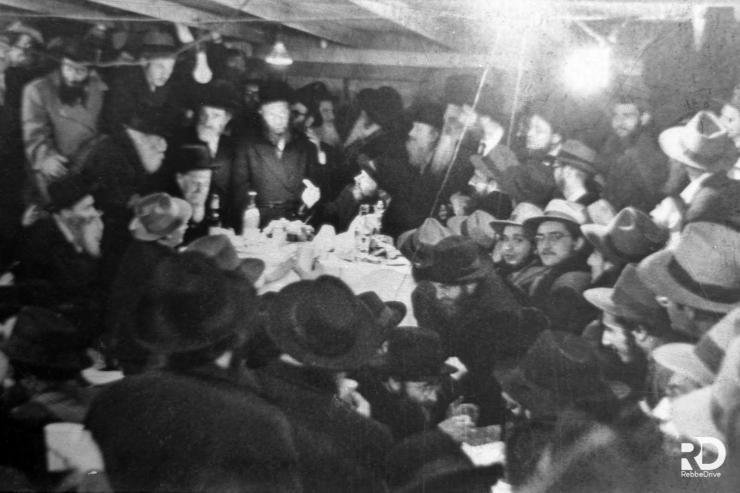Purim 5713: When The Rebbe ‘Killed’ Stalin
This year marks 71 years since the renowned farbrengen of Purim 5714, in honor of the occasion, Chabadinfo pulled out from the Beis Moshiach Archives a two-part article in which R’ Hillel Zaltzman tells the story of the Farbrengen and the Doctor’s Plot: A most frightening period in our history and the amazing denouement with the death of Stalin on Motzaei Purim after the Rebbe’s heavenly intervention on Purim 1953 • Part 1 of 2 • Full Article
This year marks 71 years since the renowned farbrengen of Purim 5714, in honor of the occasion, Chabadinfo pulled from the Beis Moshiach Archives a two-part article in which R’ Hillel Zaltzman tells the story of the Farbrengen and the Doctor’s Plot: A most frightening period in our history and the amazing denouement with the death of Stalin on Motzaei Purim after the Rebbe’s heavenly intervention on Purim 1953 • Part 1 of 2
*
From the memories of R’ Hillel Zaltzman. Prepared for publication by Avrohom Reinitz
Every year, as Purim approaches, I think back to the fear and dread that were our daily fare in the days before Purim 1953. It was the height of the Doctors’ Plot and we breathed a sigh of relief when we got the news that our mighty enemy, Stalin, had died. His death meant the end of the doctors’ trial and that the threat that hovered over us and millions of Jews in the Soviet Union was eliminated.
So that a modern-day reader will be able to understand the background of the Doctors’ Plot, we have to go back in time to my early childhood years. In those days, Stalin carried out the “Great Purge” in which he had nearly two million people murdered to establish his control of the Soviet Union. All opposition or perceived opposition was quashed.
Stalin was aided in his reign of terror by his secret police which was called the Cheka at first and later became known as the GPU, NKVD and KGB. These purges included arrests, torture, forced labor in the gulag, exile, execution, imprisonment, and show trials.
Between the years 1936 and 1938, the Minister of the Secret Police, Yezhov, arrested religious people, Jews and non-Jews. Many Lubavitcher Chassidim were arrested during that terrible time and shot to death in the cellars of the KGB on Lubianka Street (a name mentioned with dread; people were afraid to go anywhere near it) or sent to labor camps in Siberia. All of them were arrested under Paragraph 58 which forbade ‘anti-Soviet’ activity.



By the outbreak of World War II, Stalin had annihilated most of the Bolsheviks who had played a prominent role during the Russian Revolution or in Lenin’s government. Only two of them remained – Vyacheslav Molotov and Stalin himself.
At the same time as the purges were being carried out, Stalin consolidated his leadership by cultivating a cult in which he was worshipped in a manner unprecedented in the history of the modern world, perhaps even of all mankind. Stalin had himself highlighted as a hero, the creator, the father of his nation.
One of the methods used was visual propaganda. The number of portraits, posters, pictures and statues representing Stalin was virtually uncountable. An entire industry was devoted to producing portraits of Stalin. Writers and poets, movie producers and artists were directed by the government to produce works that conveyed four main messages about Stalin: As a father, creator, hero, and powerful leader. The newspapers published only laudatory articles about him. An entire generation of children was raised with blind admiration for this unparalleled monster.
In the midst of the World War II, when the enemy had invaded deep into Russia and the number of dead became known, the artificially induced personality worship which had until then been dictated from ‘on high’ was transformed into a real and heartfelt source of hope for the public at large. If there was one man who could save the country, it was Stalin.
Stalin took the highest military designation for himself, Major-General, but he did not suffice with this title since there were other generals and so he took the unique title of Generalissimo. When his own son was taken prisoner by the Germans and the Germans offered to exchange him for one of their field marshals, he turned them down and said he wouldn’t exchange a young officer for a general.
STALIN PERSECUTES HIS LOYAL JEWISH SUBJECTS
At the end of World War II, Stalin presented himself as the celebrated war leader who led the Soviet Union and saved it from the Germans. Then he turned his attention back to eliminating his enemies from within. He gradually became paranoid and murdered anyone who was suspected of being less than absolutely loyal to him.
An example of his paranoia of even his own people, were the members of the Jewish Anti-Fascist Committee, an organization which was founded during the war in order to help the Soviet Union in its war against Nazi Germany by gaining the support of world Jewry. To establish the committee, they joined together high-ranking Jewish members of the Soviet government, along with unwitting Jewish leading lights who fell into the Soviet trap. The organization’s goal was to advance the interests of the Soviet Union during the war with the help of propaganda which was based, supposedly on the condition of Jews in the Soviet Union.
After the war, Stalin used the members of the committee to further the battle against those Jews who wanted escape the Soviet Union. The members of the committee, some of whom were Yiddishists, published a newspaper in Yiddish called Einikait (Unity) in which they wrote hateful articles against Jews who wanted to leave the Soviet Union. These Jews were referred to as reactionaries and cosmopolitans.



Rabbi Hillel Zaltzman at the US Senate
After a few years though, Stalin became suspicious of the members of this organization, all of whom were Jews. He dispersed the members with the excuse that it had turned into a center of “anti-Soviet propaganda.” The chairman, Shlomo Michaels (Vofsi), the artistic director of the Jewish theater in Moscow and one of the greatest Jewish actors, was murdered by the Soviets in a staged car accident in a dark alleyway of Minsk in 1948. Over the course of the next year, the Jewish Anti-Fascist Committee was disbanded and its members were arrested. After years of interrogations and torture, the death penalty was decreed for thirteen of them.
THE AUTONOMOUS JEWISH REGION
Stalin supported the idea of a Jewish state but fought Jews who requested to go there. Stalin’s position was that anti-Semitism can’t be prevented in capitalist countries and therefore, one could understand the need for a Jewish state. However, since a communist country has no anti-Semitism, contact between Jews in communist countries and Israel is unacceptable.
When the first Israeli diplomatic mission arrived in Moscow, the Jews of Russia welcomed them joyfully. The Jews, most of whom had lost many relatives in the Holocaust, hoped that the State of Israel would be able to help them out of Russia. When Golda Meir, who headed the delegation, went to the main shul in Moscow on Archipova Street, thousands of Jews approached her with tears of joy and asked that she help them make aliya.
When Golda Meir brought up the subject with Stalin, he asked her to give him a list of people who wanted to leave. In their naivety, the delegation prepared a list and gave it to Stalin’s office. To their enormous dismay, within a short time, all the Jews whose names appeared on the list were arrested and sent to labor camps in Siberia. Many of them disappeared and till today it is not known where they are buried.
At that time, Stalin tried to advance the idea of an autonomous Jewish region. The autonomous region was actually started twenty years earlier in reaction to two threats to the Soviet Union: the Jews were a threat to atheism and the Zionists who were part of a nationalist movement were a threat to the international Soviet vision. The solution, in the communists’ opinion was to establish a Jewish region which would provide Jews with a national homeland, though not in Israel, where the language would be Yiddish, not Hebrew.
Efforts were made to promote emigration to the area. Posters were made and forms dropped from the air over areas where Jews lived. Books were written in Yiddish about the socialist utopia. The government even produced a movie in Yiddish called “Those Who Seek Happiness” about a family which left the United States because of the poor economy and arrived in this region.
The propaganda was so effective that even thousands of Jews who weren’t Soviets emigrated there including hundreds who had lived in Palestine. At a certain point the number of Jews in the region reached a peak of about a third of the local population. Between 1945 and 1948 the total Jewish population was about 30,000.
With the founding of the State of Israel, Stalin went back to his idea of an autonomous Jewish area. The government advertised that whoever went there would receive a farm animal for free and a gift of 18,000 rubles. Lubavitchers joked and said that was the best case scenario, but in fact those Jews would be lucky to receive a Jewish burial.
SHOCKING ARRESTS IN SAMARKAND
Unlike the great purges that took place in the years prior to World War II that were directed at the general population, a wave of arrests between the years 1948-1953 targeted Jews, religious and irreligious.
Where we were in Samarkand, there were many arrests of Jews whose only crime was that they were associated with Chabad Chassidim. That was enough to earn one the title of counter-revolutionary.
R’ Simcha Gorodetzky, who was sent to Samarkand by the Rebbe Rayatz, sent bachurim from there to learn in Tomchei T’mimim yeshivos. After they returned to their communities they taught Torah and Judaism in Samarkand and its environs. Many of these Chassidim were arrested.
One of those arrested was Rabbi Avrohom Chaim Ladaiov who, during the war, built a mikva in the cellar of his home. The mikva was used by the many refugees who came to the city and was known as “Avrohom Chaim’s Mikva.” After the war, when the persecutions began against the Jews, R’ Avrohom Chaim was afraid and he removed the water from the mikva. He covered the pit with blankets and shmattes.
Apparently someone tattled to the KGB and their agents went to arrest him. They found him sitting at the table in his home. Since the arrests were accompanied by massive propaganda in the newspapers, the KGB searched for a way to present him as a dangerous criminal who was fleeing the law. They took him down to the cellar, removed some of the blankets, put him in the pit and covered him with the blankets and they photographed him. In his file appeared the picture of a traitorous Jew who tried to hide from the law.
A horrifying thing happened when they went to arrest R’ Z’vulun Leviev, the grandfather of the philanthropist Lev Leviev. A member of the household noticed the police approaching the house and R’ Z’vulun quickly hid in a hiding place that he had prepared long before. One of the walls of the house was a double wall and a person was able to hide there.
It seems that whoever informed on him supplied the KGB with the information about the hiding place, for when the policemen didn’t find him, they began to poke the walls with their bayonets. Eventually, they approached his hiding place and stabbed him in the head. It was only by a miracle that he wasn’t killed by the bayonet. He shouted out in pain and that is how his hiding place was discovered.



I remember how they brought him to jail. At the time, we all lived in the Jewish quarter in the old city. It was like a closed ghetto and everybody knew about everybody. When they came to arrest someone, they came with many men and began to search and the entire procedure took about two hours. During this time, the news spread throughout the Jewish quarter and hundreds of Jews, men, women, and children would show up. When they found the person at home, everybody would cry, for they knew what the end would be.
Even according to what we were used to in those days, with arrests happening every day, his arrest was a terrible sight. Blood flowed from his temple as two KGB men dragged him and put him in the black truck. Policemen armed with rifles stood on either side of him.
In those dark days they also arrested Rabbi Mulle Chizkiyahu who was the only Chassidic rav of the Bucharian Jews; the shochet Mulle Yosef, and others.
They once arrested a blind Jew, a very simple person whose name was Rebbi (a common name among Bucharian Jews). When he was interrogated, he maintained that he was a simple person who couldn’t even learn on his own and why were they accusing him of activities against the government?
We don’t care, said the interrogators. We know that you say the T’hillim after the davening, one of the enactments of Rabbi Schneersohn, and that’s enough to incriminate you for associating with a counter-revolutionary organization.
My uncle, a shochet named R’ Chaim Boruch Duchman, was loved by all and when they found out that the KGB had their eye on him, some local Jews went to warn him to run, otherwise he would be arrested. He fled immediately and hid in another neighborhood of the city. He remained hidden there until Stalin died, a year and a half later.
The fear of the unknown was so powerful that upon the death of R’ Moshe Yachovov, a Bucharian Chabad Chassid and a friend of R’ Mendel Futerfas, my mother said: R’ Moshe is a lucky man. He died in his bed, was given a Jewish burial, his children accompanied him to his resting place and they can visit his grave. As for the dozens of Jews who were arrested, nobody knows what will happen to them. We can assume that they will be shot or die of forced labor in Siberia and nobody will know where they are buried.
In the end, as will be related, the situation changed for the better with the death of Stalin, and most of those who were arrested were released and returned home. That’s when my mother repeated the aphorism – you can return from anywhere but not from there …
[To be continued be”H]
926
Join ChabadInfo's News Roundup and alerts for the HOTTEST Chabad news and updates!











































